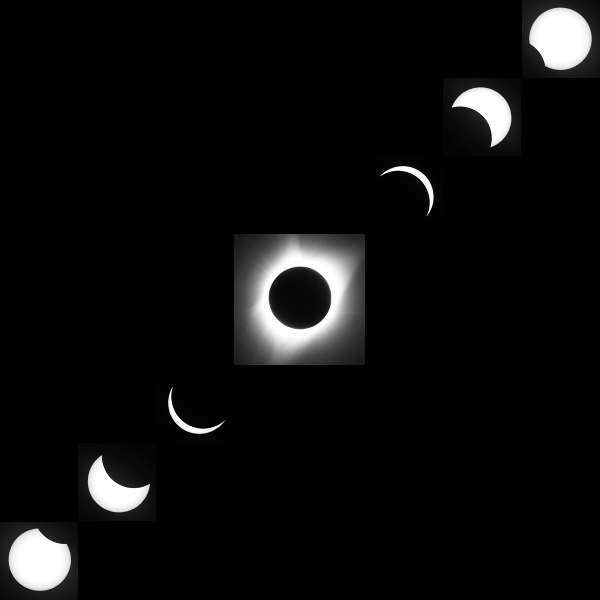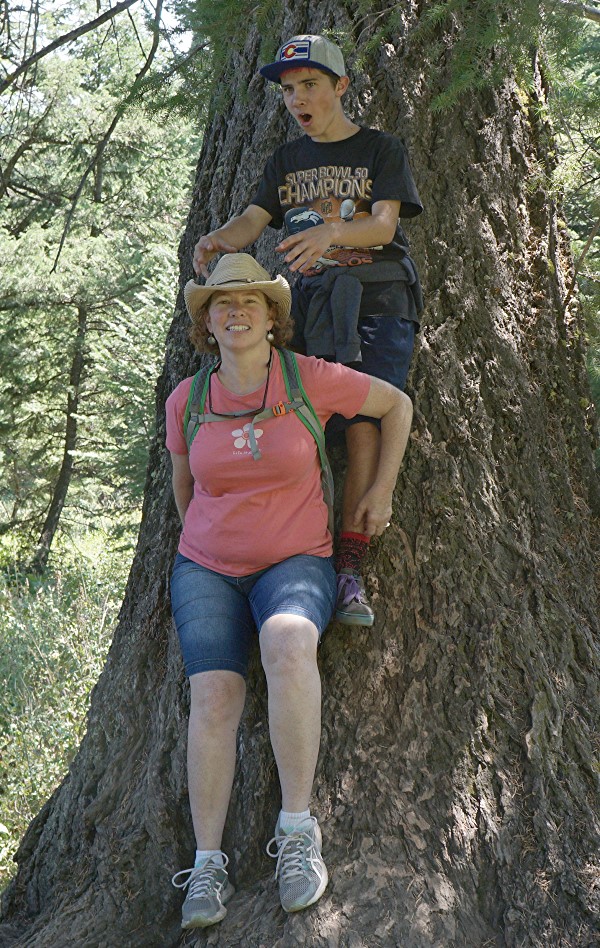Total eclipse of the sun
I got an unexpected opportunity to travel to Jackson, Wyoming, in the Grand Tetons,
to see the eclipse on August 21. I took a lot of pictures, but the bottom line is these phases of the eclipse:

The sky was clear, the time was near noon, and you could see the moon eat into the sun right along the ecliptic.
More below the fold.
It was impossible to find “proper” photographic filters with the required optical density of 5 or 6 (an attenuation of 105 or 106), so I cut up a pair of cardboard goggles, mounted them in an adapter ring, and screwed the assembly into a 300 mm (35-mm equivalent) zoom lens:
Well before leaving, I took some test pictures of the sun:
Yes, those are sunspots toward the lower left. Contrary to public opinion, the sun is white. I am uncertain why the image is red, but I presumed because the filter is not truly neutral, that is, gray. I saw a similar test picture somewhere before the eclipse, however, and the photographer had used a “proper” filter, yet his picture was also red. Perhaps some reader can, um, shed some light.
The entire expedition to Jackson cost an amount roughly equal to my grandson Toby’s inheritance, so I thought the least we could do was bring him along. This is a picture of Toby walking all over his mother Rachel along a trail to Phelps Lake:

The eclipse began at 10:17 local time. I set my camera for F/8 and 1/250 s, consistently with the test photograph. I set the camera to exposure bracketing with an interval of 2 F-stops, so the camera took three pictures within a fraction of a second.
When the partial eclipse began, we used certified cardboard goggles to look at the sun:
After a while, my wife Deanna grew tired of the goggles and broke out a pinhole camera she had made of a shoebox and a small pinhole punched with a needle into a black, 5-mil (125 μm) plastic sheet:
When she tired of the pinhole camera, she took out a colander and observed multiple pinhole-camera images of the sun:
Meanwhile, I searched around for some similar images caused by the gaps between leaves in a tree. These images fell onto a beam on the side of a porch:
Such images were known to the ancient Greeks and explained by Aristotle, but the pinhole camera was not developed for many centuries.
It began to get cold when the eclipse approached totality. I did not notice any insects or other creatures behaving oddly, but the local human population in a nearby park uttered sounds indicating excitement. They uttered similar sounds at the end of the period of totality. As for me, I removed the filter from the lens. Exposure bracketing was not particularly important during the partial phases of the eclipse, but I frankly did not want to spend my 2 min fiddling with a camera when I could be watching an eclipse. I estimated the exposures from a table kindly provided by Fred Espenak, who has posted a handful of guides for eclipse watchers. As before, I set the camera to take three exposures, 2 F-stops apart. I took a few pictures and then increased the exposure by 5 F-stops, before taking another few pictures.
The lowest exposures revealed some solar prominences:
One of the longest exposures showed the extent of the solar corona:
The period of totality ended all too quickly, and we saw the “diamond ring” as the sun emerged from behind the moon:
I am afraid the photograph is a bit overexposed (I never had particularly good reflexes), and I have no idea why part of the rim of the sun appears violet, but I assume it is an artifact of the photographic process. I think we can also see three prominences along the edge of the upper right quadrant.
For the next little while, the sun went through its previous phases in the reverse order, and the eclipse was done.
